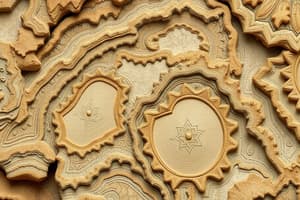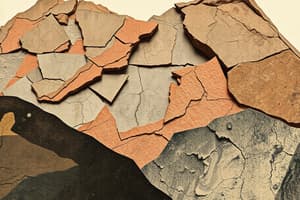Podcast
Questions and Answers
What is the original rock called before it becomes metamorphosed?
What is the original rock called before it becomes metamorphosed?
- Parent rock (correct)
- Foliated rock
- Intrusive rock
- Daughter rock
Which type of metamorphic rock is characterized by a layered or banded appearance?
Which type of metamorphic rock is characterized by a layered or banded appearance?
- Foliated (correct)
- Intrusive
- Non-foliated
- Sedimentary
What primarily drives the process of regional metamorphism?
What primarily drives the process of regional metamorphism?
- Exposure to weathering
- High temperatures only
- High pressure and temperature (correct)
- Direct heat from magma
Which process involves less alteration and affects a smaller area of rock?
Which process involves less alteration and affects a smaller area of rock?
During metamorphism, what happens to minerals in the rock when pressure is greater in one direction?
During metamorphism, what happens to minerals in the rock when pressure is greater in one direction?
What is a defining characteristic of non-foliated metamorphic rocks?
What is a defining characteristic of non-foliated metamorphic rocks?
Where can metamorphism primarily occur due to high pressure and temperature?
Where can metamorphism primarily occur due to high pressure and temperature?
Which statement best describes contact metamorphism?
Which statement best describes contact metamorphism?
Flashcards
Metamorphic Rock
Metamorphic Rock
A rock that has been changed by heat and pressure without melting.
Parent Rock
Parent Rock
The original rock before it undergoes metamorphism.
Daughter Rock
Daughter Rock
The newly formed metamorphic rock after the transformation.
Foliated Metamorphic Rock
Foliated Metamorphic Rock
Signup and view all the flashcards
Non-Foliated Metamorphic Rock
Non-Foliated Metamorphic Rock
Signup and view all the flashcards
Regional Metamorphism
Regional Metamorphism
Signup and view all the flashcards
Contact Metamorphism
Contact Metamorphism
Signup and view all the flashcards
Hydrothermal Metamorphism
Hydrothermal Metamorphism
Signup and view all the flashcards
Study Notes
Metamorphic Rocks
- Metamorphic rocks form when high temperatures and pressure alter a rock's composition, texture, or mineralogy without melting it.
- The original rock is called the parent rock, and the altered rock is the daughter rock.
- Metamorphism occurs in areas of high pressure and/or temperature, such as deep within Earth, near magma intrusions, and near convergent plate boundaries.
- Metamorphic rocks can be classified into two main groups: foliated and non-foliated.
Foliated Metamorphic Rocks
- Foliated rocks exhibit a layered or banded appearance due to directed pressure.
- Needle-like crystals align with their long axes perpendicular to the pressure source.
- Examples include slate, phyllite, schist, and gneiss.
Non-Foliated Metamorphic Rocks
- Non-foliated rocks lack a layered or banded appearance; directed pressure was not present during formation.
- Examples include marble and quartzite.
Types of Metamorphism
- Contact metamorphism: Occurs when hot magma heats surrounding rocks. The area affected is relatively small (less than 100 meters squared).
- Regional metamorphism: Occurs during mountain-building. Large areas of rock are subjected to high pressures and temperatures deep within Earth.
- Deformational metamorphism: Occurs at relatively low temperatures but with high pressures, often at faults where rocks move past each other. It causes rocks to deform or change shape.
Studying That Suits You
Use AI to generate personalized quizzes and flashcards to suit your learning preferences.




